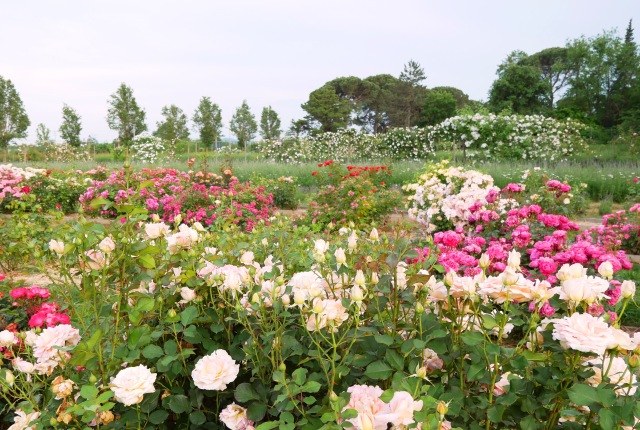Perhaps not everyone knows that the University of Bologna mantains and manages a teaching and experimental rose garden comprising around 1,500 plants divided into 200 varieties, at the 'Persolino-Strocchi' Professional Institute on Faenza’s Persolino hill. Named after Raffaele Bazzocchi, a professor of the University of Bologna who opened it in 1997, the rose garden has for some years now also hosted an international competition - “The Unibo International New Rose Trials” - dedicated to new rose selections for gardening and modern, sustainable landscaping.
Organised with the support of the World Federation of Rose Societies (WFRS) and the Italian Society of Horticulture (SOI), the competition aims to assess annually about seventy new rose selections not yet on the market, submitted by leading European and international hybridisers. This year's edition took place on Saturday, 25 May.
“Each new hybrid can earn a maximum of 30 points for plant appearance, up to 30 points for its flowers, 10 points for its fragrance and a further 30 points for pathogen resistance,” explains Maria Eva Giorgioni, professor at the Department of Agricultural and Food Sciences and scientific director of the rose garden. “Roses intended for public and private gardens should not be merely beautiful and fragrant; they should also be resistant to disease, thus avoiding the need for treatments and therefore promoting sustainability.”
The rose garden is located on the site of the 19th-century garden of Ludovico Caldesi, a Faenza nobleman and politician who had a passion for botany, a discipline to which he devoted himself completely after the premature death of his son. Upon Caldesi's death, a Foundation was established with the task of setting up an institute for agricultural technicians—the modern day “Persolino-Strocchi” Professional Institute. The rose garden, established in the late 1990s, springs from a meeting between Professor Raffaele Bazzocchi, an expert in ornamental plants at the University of Bologna, and Umberto Montefiori, then headmaster of the “Persolino-Strocchi” Institute.
“At that time, Professor Bazzocchi had realised that in order to boost the nursery-ornamental sector, it was important to focus on the cultural aspect of plants; not only their beauty, therefore, but also their history and the emotions they arouse. Understanding how these plants have reached us means knowing about the people who introduced and preserved them and the significance of the place that hosts them,” says Professor Giorgioni. “As a result, we decided to focus on ancient roses, which are rich in history and very valuable from an agronomic point of view, because they require low maintenance and adapt very well to our climate: they are the ideal choice, even today, for sustainable gardening.”
Today, however, ancient roses are no longer a novelty, and the University of Bologna rose garden has therefore chosen to shift its focus towards modern landscape roses - suitable for public green spaces with their long flowering period - without however foregoing the ancient varieties altogether: there is still an educational pathway dedicated to “roses through time”, from specimens from ancient Egypt through to the most modern ones.
“Upon walking through the rose garden, you can observe the genetic evolution of this plant, whose oldest origins seem to lie in Asia Minor,” concludes Professor Giorgioni. “From there, one evolutionary line moved towards the Mediterranean and another towards Asia: ‘Chinese’ roses arrived in Europe in the late 18th century, mainly thanks to the East India Company. Extensive hybridisation between these two lines has resulted in re-flowering roses with different habits and a wide range of flower colours and shapes, right up to the ones that are now being assessed in the competition.”

